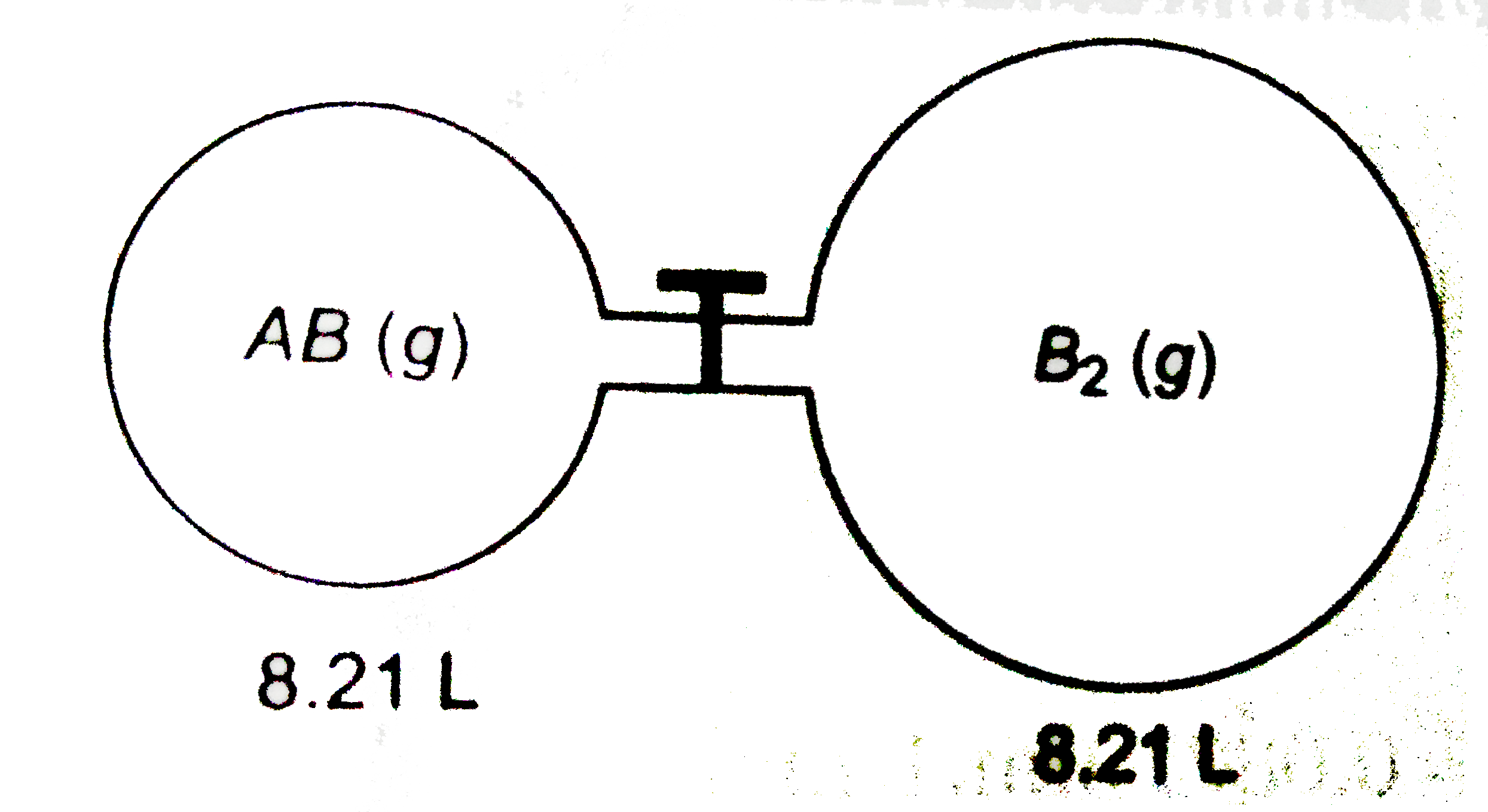At room temperature following traction goes to completion
2AB(g)+B2(g)→2AB2(s)
AB2 is solid with negligble vapour pressure below 0∘C. At 300 K, the AB in the smaller flask exerts a pressure of 3 atm and in the larger flask B2 exerts a pressure of 1 atm at 400 K when they are separated out by a close valve, The gases are mixed by opening the stop cock and after the end of the reaction the flask are cooled to 250 K

The final pressure is :
0.156 atm
0.3125 atm
0.625 atm
3.2 atm
The correct Answer is:c
(c) nAB=3×8.210.0821×300=1,
nB2=1×8.210.0821×400=0.25
2AB(g)+B2(g)→2AB2(s)
Initial moles10.25After reaction0.50
PAB×(8.21+8.21)=0.5×0.0821×250
PAB=0.625atm
Topper's Solved these Questions
- BOOK - NARENDRA AWASTHICHAPTER - GASEOUS STATEEXERCISE - Level 1 (Q.31 To Q.60)1videos
GASEOUS STATE
- BOOK - NARENDRA AWASTHICHAPTER - GASEOUS STATEEXERCISE - Level 1 (Q.121 To Q.150)1videos
GASEOUS STATE
- BOOK - NARENDRA AWASTHICHAPTER - ELECTROCHEMISTRYEXERCISE - Level 3 - Subjective Problems1videos
ELECTROCHEMISTRY
- BOOK - NARENDRA AWASTHICHAPTER - IONIC EEQUILIBRIUMEXERCISE - Exercise196videos
IONIC EEQUILIBRIUM
Similar Questions
At room temperature following reaction goes to cormpletion 2NO+O2→2NO2→N2O4
Dimer N2O2 at 262K is solid. A 250 ml flask and a 100 ml flask are separated by a stop cock. At 300 K, the nitric oxide in the larger flask exerts a pressure of 1.053 atm and the smaller one contains O2 at 0.789 atm. The gases are mixed by opening the stop cock and after the. end of the reaction, the flasks are cooled to 220 K. Neglecting the vapour pressure of dimer find out the pressure and composition of gas remaining at 220 K. (Assume gases behave ideàlly).View SolutionAt room temperature, the following reaction proceeds nearly to completion:
2NO+O2→2NO2→N2O4
The dimer, N2O4, solidfies at 262K. A 250mL flask and a 100mL flask are separated by a stopcock. At 300K, the nitric oxide in the larger flask exerts a pressure of 1.053atm and the smaller one contains oxygen at 0.789atm. The gase are mixed by opening the stopcock and after the end of the reaction the flasks are cooled to 220K. Neglecting the vapour pressure of the dimer, find out the pressure and composition of the gas remaining at 220K. (Assume the gases to behave ideally)View Solution
Knowledge Check
- Question 1 - Select One
1gH2,2g He and 3g NO are contained in 1.1 L flask at 300 K. Total pressure exerted by the mixture is :
A5.45 atmB6.0 atmC24.63 atmD134.34 atm - Question 2 - Select One
The stop cock connecting the wo bulbs of equal volume at pressure 2 atm and 1 atm is opened at constant temperature then
Athe final pressure will become 3 atmB14th gas from bulb 1 will be transferred to bulb 2C12 art of the gas present initially in bulb 2 will be added into bulb 2D14th of the gas present initially in biulb 2 will be added into bulb 2
At room temperature, the following reaction proceeds nearly to completion:
2NO+O2→2NO2→N2O4
The dimer, N2O4, solidfies at 262K. A 250mL flask and a 100mL flask are separated by a stopcock. At 300K, the nitric oxide in the larger flask exerts a pressure of 1.053atm and the smaller one contains oxygen at 0.789atm. The gase are mixed by opening the stopcock and after the end of the reaction the flasks are cooled to 220K. Neglecting the vapour pressure of the dimer, find out the pressure and composition of the gas remaining at 220K. (Assume the gases to behave ideally)View Solution1 g of helium gas is confined in a two-litre flask unser a pressure of 2.05 atm. What is temperature ?
View SolutionA sample of HI(g) is placed in flask at a pressure of 0.2atm. At equilibrium. The partial pressure of HI(g) is 0.04atm. What is Kp for the given equilibrium?
2HI(g)⇔H2(g)+I2(g)View SolutionA mixture of 2 g hydrogen and 64 g oxygen exerts a pressure of 3 atm. Partial pressure of oxygen will be.....
View SolutionAt temperature T, a compound AB2(g) dissociates according to the reaction
2AB2(g)⇔2AB(g)+B2(g)
with degree of dissociation α, which is small compared with unity. The expression for Kp in terms of α and the total pressure PT isView SolutionA sample of HI(g) is placed in flask at a pressure of 0.2atm. At equilibrium. The partial pressure of HI(g) is 0.04atm. What is Kp for the given equilibrium?
2HI(g)⇔H2(g)+I2(g)View Solution

